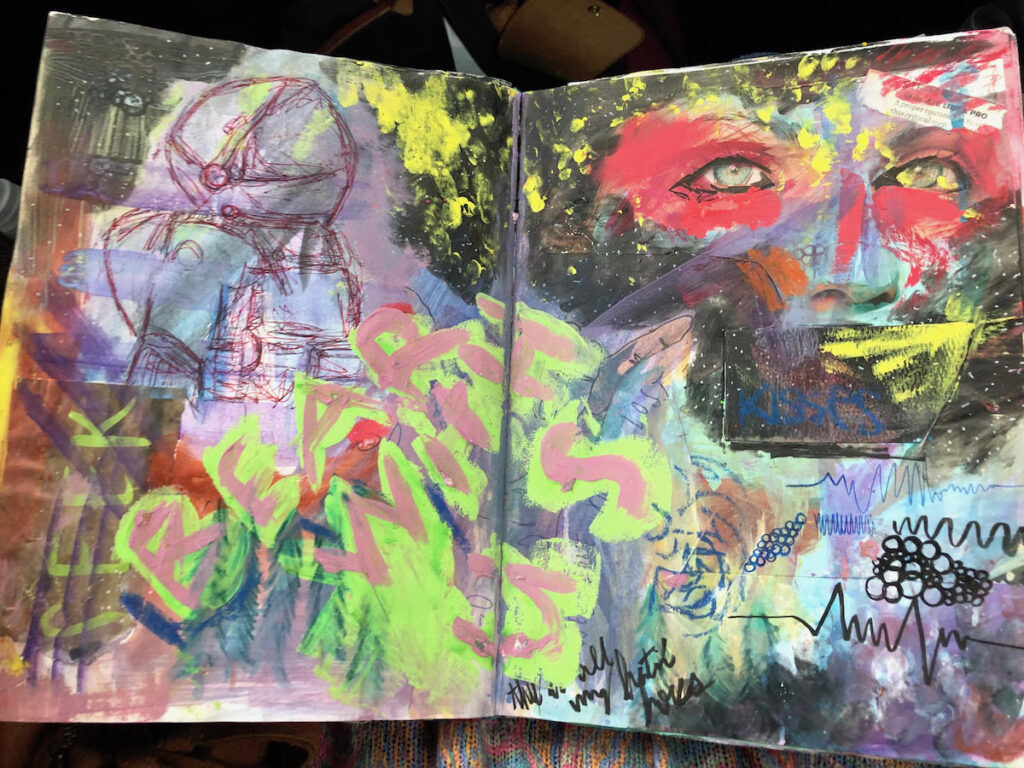I don’t know about you, but I love working in a sketchbook or visual journal. They are such great tools for both teachers and students to experiment, think, brainstorm, sketch, and play with art materials.
Often, working in a sketchbook is a solo experience. We might ask students to work out ideas for a new project or experiment with new media, but that’s where it ends. I began to think that adding a collaborative element to my students’ sketchbook experience could push them even further.
And so began a collaborative sketchbook swap!
The students and teachers in my district were already participating in an Artist Trading Card program. It was always fun to see each teacher’s individual style as well as the work their students were doing. A colleague of mine, Brooke Adamson, threw out the idea of doing teacher and student sketchbook swaps, and the teachers jumped at the occasion. With Brooke’s guidance, an incredible event took place!
Here are a few tips if you are interested in trying something similar.

1. Decide who’s in.
Create a list of interested schools and the teachers who want to participate. You will need to decide how much time each school will have the sketchbooks before they are returned to their “home” school for the same amount of time. We decided on a two week time period. Once you determine a timeframe that will work for all the interested schools, create a yearlong schedule for everyone to follow.
2. Choose your sketchbook wisely.
Decide on the book you and your students will use. A hardbound 9” x 12” sketchbook is a good choice due to the amount of traveling in store. You will also need to figure out a way to wrap the books to keep them safe in transit. Gluing a copy of the schedule inside the back cover as well as a signature page where students and teachers can sign and date the books is a great idea. You’ll also need a title page, so others know to whom the book belongs.
3. Nail down the logistics.
Select the students who want to participate. A sketchbook swap can be work intensive for students, so buy-in is essential. Offering the opportunity to more advanced or NAHS students is a good way to begin. Students can sign up to take the book home either one night a week or over a weekend. You might also hold surprise journal days in class, encouraging students to work collaboratively and discuss the work that has already been done.
Looking for other ways to incorporate sketchbooks into your classroom? Be sure to check out the Sketchbook Ideas that Really Work PRO Learning Pack!
The Results

Working in Others’ Sketchbooks
The first time we wrapped up our books and put them in the mail room to be delivered, we were a bit nervous. What would the books look like in two weeks? Did we actually want other students drawing in our journals? Would they appreciate the marks we were about to make in theirs? There were so many unknowns, which is part of the fascination with this project.
A few days later we received our first journals from another school. The conversations that ensued told me that we did the right thing to get involved in the swap. The journals sent to us had great work to start with. There were sketches, collages, drawings, and some paintings.
My students very carefully began to add their marks into these pages. Listening to their thoughtful and caring conversations made me realize they were really learning from one another while respecting the art of others. I had the same feeling as I was going through the teacher’s personal book and adding my marks to her pages.

Having Others Work in Our Sketchbooks
At the end of the two weeks, we sent their journals back, and we received ours back, and Wow, was it exciting! Of course, my students didn’t immediately love everything that had been done to their work. But, they had the opportunity to go into the book and continue to play and experiment with where it could go. I had the same opportunities, and within a few months, we got into a routine. Students loved taking the journals home, working on them, and passing them around the next day for everyone to see. I loved working in my colleagues’ journals and seeing where they would take my marks. It became a fantastic learning experience for everyone involved.
Although this activity can be time consuming, it will quickly become an activity that your students will deeply care about. My students learned so much about collaborating, respect, time management, and how to share thoughtful responses, and I know yours will too!
Another reason I love this project is that it can be an excellent learning tool. We often get so caught up in our own programs and curriculum that we forget about the wonderful network of art teachers we have to lean on. Seeing these journals was like a peek into other teaching philosophies and student learning. Overall, we all felt great about our final book when it came back to us after traveling to ten schools in ten months. I encourage you to try something similar and see where the experience takes you!
Have you ever considered doing a sketchbook swap with other teachers and schools?
How do you encourage collaborations within your art program?
Magazine articles and podcasts are opinions of professional education contributors and do not necessarily represent the position of the Art of Education University (AOEU) or its academic offerings. Contributors use terms in the way they are most often talked about in the scope of their educational experiences.





